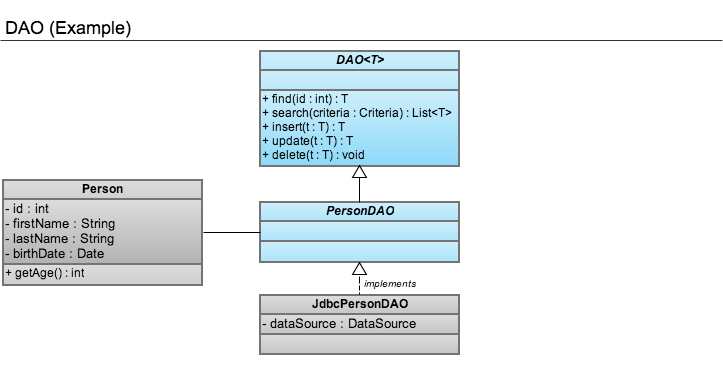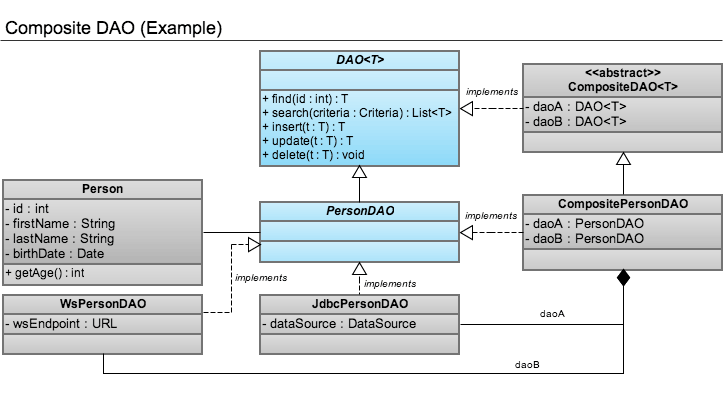Composite Dao Pattern Abstracting multiple data sources
Let’s talk about what a Composite DAO is and why you would consider creating one. I introduce the pattern, and then I provide a common example where it is a valuable tool. For a demonstration, you can fork my demo composite-dao project.
Introduction
What is Composite DAO?
Composite DAO is an object oriented design pattern. Actually, it is a combination of two design patterns:
As most JEE and .NET developers are aware, DAO objects perform the platform-specific logic required to read, write, and delete persistent domain model object state. The DAO interface is typically associated with a single domain model or entity class. Each implementation of the DAO interface is then specific to a particular persistence platform. So, given a Person domain model class, the basic design would look something like

The Composite DAO pattern is an extension of the Data Access Object pattern, where the composite object is an implementation of the same DAO interface implemented by the objects of which it is composed. Employing this pattern, one can assemble nested structures of DAO objects, each of which may:
- Encapsulate logic for a specific persistence mechanism (RDBMS, file, directory service, etc.)
- Be a composite DAO itself!

To better understand the value of this pattern, let’s talk through some examples where it is beneficial.
Example: Local vs Remote
In this scenario, the System of Record is remote to the application. It may be a mainframe records system, a centralized data warehouse, or some black box-type system exposing a web service interface. Regardless, the platform is remote and therefore ‘expensive’ to connect and interact with. Persistent operations on Person objects in this system are all done inside a RemoteSystemPersonDAO object.
To mitigate the expense of going back and forth to the remote system, the application uses a local database which acts as the System of Reference. “Local” may mean the database physically resides on the same server as the application, or it may simply mean the database is within the same network. The main point is that the local database is ‘cheap’ to connect and interact with, relative to the expense of the remote system of record. Persistent operations on Person objects in this system are all done inside a LocalDatabasePersonDAO object.
For a service-layer object in the application, there will have to be some chunky but possibly boilerplate logic to determine which DAO object(s) to use for any given operation on a domain model entity. What happens when the company moves to a new system of reference? What level of refactor would that incur? What if yet another data storage system gets introduced… meaning another DAO implementation? Yikes!
To simplify the service-to-DAO interaction, we can use the Composite DAO pattern. Here, we would have a PersonCompositeDAO object that the service uses. It handles 2 things:
- Abstraction of the local and remote DAOs away from the service. The service now deals with 1 DAO.
- Moves the “which place do I go?” decision logic out of the service and into the DAO layer.
Conclusion
I hope I have shown you the promise and value of the Composite DAO pattern. Again, if you’d like to see a concrete example, check out the composite-dao project.
blog comments powered by Disqus